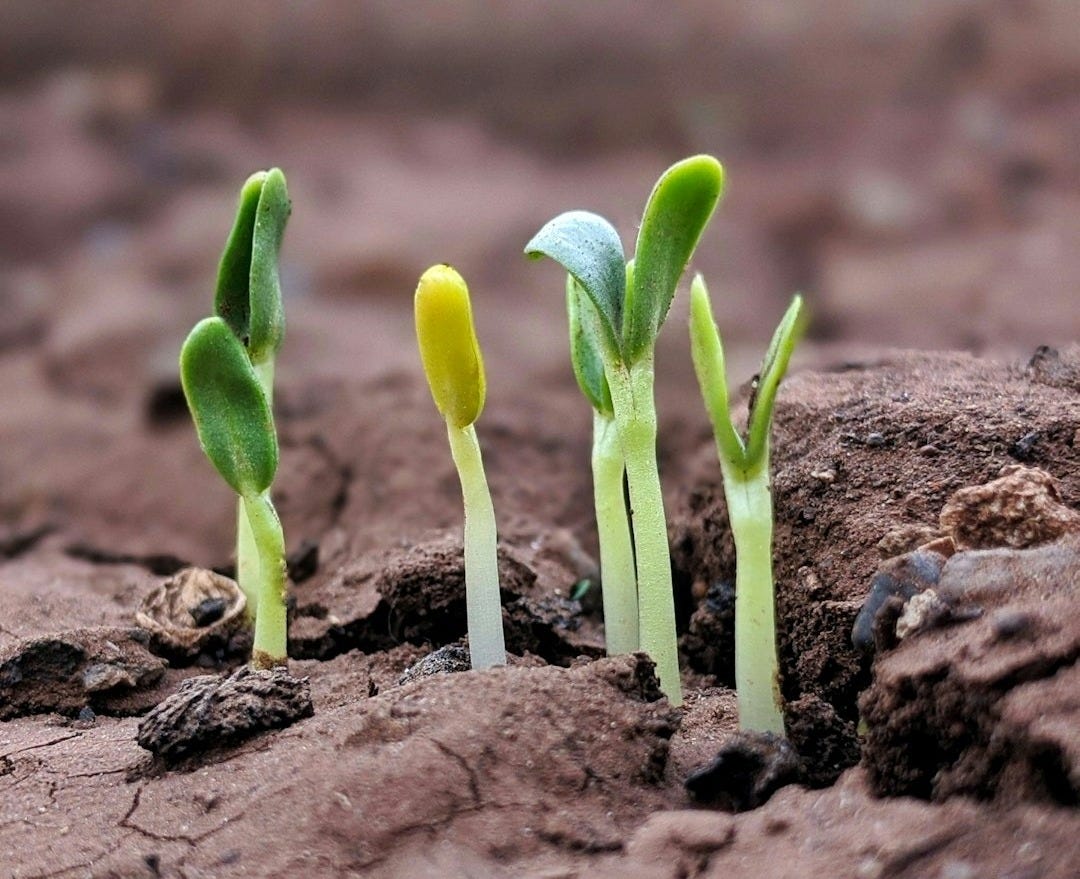Save Our Seeds, Part 1: Why local heirloom vegetables are important
We wouldn't have heirloom tomatoes if no one saved their seeds. And yet, most American farmers don’t collect seeds. What's going on?
Quick note: Climate Culinarians just switched from a monthly newsletter to a weekly newsletter! There will be one topic for the whole month (like before), and each week is dedicated to a different focus. Learn more about the new structure here.
Dear Climate Culinarians,
I can’t say why, but lately, I’ve been drawn to beginnings. Which led me here:

Ahhh, looking at the greenery of sprouting seeds … feels like exactly what I needed. And I hope you enjoy it, too. Because this month’s newsletters are going all the way to the original origin story of plant-based food: seeds. More specifically: Saving seeds.
What is seed saving?
You can collect seeds to eat them. Or to sow them next spring. Or to save them in case of an emergency … Okay, I’m getting ahead of myself. I promised you beginnings, not world’s-end-scenarios. So let’s start with the beginning.
Tomato and basil, rice and beans: Our food plants start with a seed. Some, like almond trees or blueberry bushes or asparagus, will produce food for more than one season. Many other vegetables, grains and legumes won’t. So whoever grows this food will need seeds.
For thousands of years, gardeners and farmers have been collecting those seeds themselves. They allow a few stalks of basil to bloom and go to seed.
Let a bean pod dry out and collect the beans.
Set apart some sunflower seeds before you (or the birds and squirrels) ate them all.
That’s how seed saving can start. The goal is to
harvest seeds,
carefully store them,
and then grow new, tasty plants.
And yes, compared to buying seeds, seed saving requires time and effort. Plus extra space, for growing (extra) plants and for drying and storage.

Why is it a good idea to save seeds?
There are many advantages to collecting seeds at the end of the growing season.
Seed savers save money. They have a supply for next year and don’t need to buy new seeds.
Seed savers get to be picky. Literally. By picking seeds from the best tasting or least water-guzzling plants, they raise their chance to grow new plants featuring the qualities they love.
Seed savers create hyperlocal plants. Because year after year, these plants will adapt more to the seed saver’s location’s climate and growing conditions.
Seed savers help pollinators. Saving seed means that more plants in a garden or field will be allowed to flower.
Seed savers contribute to biodiversity. So everyone can have a choice of tasty foods - and plant traits. Which is crucial while we adapt to changing climate conditions.
Seed savers preserve food culture. If no one had saved their seeds, heirloom tomatoes like Brandywine and Yellow Pear wouldn’t exist. Nor would the Cherokee Trail of Tears bean. And the prettily pink-and-white striped ‘Chioggia’ beets from Italy wouldn’t adorn social media.
Saving seeds was the way to go for thousands of years. It made sense. Until it didn’t.
What’s the problem with seed saving?
In a nutshell, a food and agriculture policy went awry. It was meant to secure our food supply after the experiences of the Great Depression and World War II.
The goal was to create many different varieties of food plants. Because then, if one fails, we would have plenty others to fall back on.
Go ahead, give us wheat that can withstand these darn droughts, give us a chili pepper that salsa manufacturers can work with.

Low-maintenance on the fields, frost-resistant, easy to harvest, perfect for canning. Bigger fruit, better taste, longer shelf life … The wish list never ends. That’s how hybrid seeds arrived on the market.
Hybrid plants are grown for specific qualities. And they give their all in one shot. Seeds from many hybrids are infertile. And if they do sprout, chances are you’ll grow a very different plant.
It didn’t make sense to save hybrid seeds. But their arrival was not the only problem that seed saving farmers and gardeners were going to face. Sources for new vegetable and crop varieties were changing, too. In the 1970s, breeding new plants shifted from public institutions to private companies.
Breeding a new kind of cabbage or corn requires a lot of trial and error. It costs time and money. Plant breeders wanted to balance their books. And they found a way to literally reap the benefits from their efforts:
They demanded ownership. To plants!
Eventually, lawmakers allowed companies to claim: “This plant belongs to me, and only me” - through intellectual property rights. Breeding a new broccoli was now considered an invention, and breeders could get a patent. This reward led to a lot of research. To new and improved food plants. And also to unintended consequences. Because farmers can’t save and grow seeds from a plant that someone else owns. Just like you can’t use an Ikea plant pot design to build and sell yours.
Is seed saving illegal now?
You’ll see … in next week’s newsletter. Part 2 of „Save Our Seeds“ reveals which companies own the most seeds, and what that means for seed saving. You’ll read about seed initiatives who care about climate-adapted plants, food security, biodiversity and heirloom vegetables. Plus: how you can help save our seeds. No garden required. Until then:
Read, write, eat, repeat!
Petrina
Climate Culinarians is a project by me, Petrina Engelke. I write about climate, food and the U.S., and I help other writers turn their ideas into a book people want to read. In other words: I’m a journalist and a book coach.


